Published on January 22, 2021 by Morgan Black

Sara Helms McCarty, a professor of economics in Samford University’s Brock School of Business, has coauthored a new research article titled “In or Out or Somewhere in Between? The Determinants of Gradual Retirement.” This article was published by the academic Journal of Family and Economic Issues in January 2021.
In summary, McCarty’s article examines the determinants of gradual retirement decisions of older workers. The article states, “The very definition of retirement has changed. Rather than leaving the labor force completely, many full-time workers engage in gradual retirement. Gradual retirement involves leaving full-time employment for part-time employment, either with the same employer or another employer.”
Her research uses data from the Panel Study of Income Dynamics (PSID) and econometric analysis. The results of her study indicate that older individuals, Black individuals, and individuals with higher nonlabor income are more likely to engage in gradual or full retirement. They also indicate that married individuals, college graduates, and those who are in good health are less likely to either gradually or fully retire. The 60s are the time most people engage in gradual retirement.
At Samford, McCarty teaches Principles of Microeconomics, and Public Policy and Econometrics, and serves as the coordinator of the Brock Scholars program. Her research interests include applied microeconomics and public policy, particularly in the areas of volunteering, charitable giving, education policy and public health policy. She uses both traditional econometric and experimental methods. She has presented her work at the annual meetings of regional, national and international organizations, including the American Economic Association and the Southern Economic Association, among many others.
McCarty’s coauthor, Charlene M. Kalenkoski, is a professor of personal financial planning at Texas Tech University.
Samford is a leading Christian university offering undergraduate programs grounded in the liberal arts with an array of nationally recognized graduate and professional schools. Founded in 1841, Samford is the 87th-oldest institution of higher learning in the United States. Samford enrolls 6,101 students from 45 states, Puerto Rico and 16 countries in its 10 academic schools: arts, arts and sciences, business, divinity, education, health professions, law, nursing, pharmacy and public health. Samford fields 17 athletic teams that compete in the tradition-rich Southern Conference and ranks with the second highest score in the nation for its 98% Graduation Success Rate among all NCAA Division I schools.

